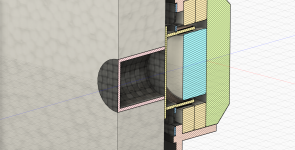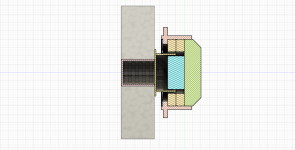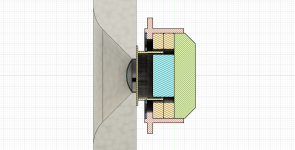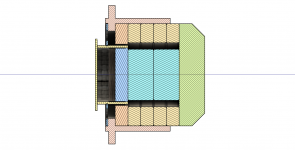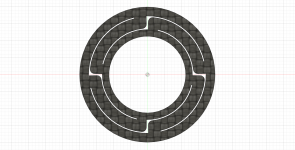Thanks Steve, interesting question.I should have said would it drive both front and back surfaces equally?
Steve.
My first thought is that it would but there are a couple of questions that arise.
The added mass of a metal bolt would increase the moving mass which is undesirable from the perspective of the motors performance. If it could be achieved using a CF tube or in the case of Option 3 an extension of the armature epoxied in place that would reduce the mass penalty.
On thin wall panels I am not certain if there is an advantage as the pulse from the exciter is transmitted through the thickness of the board very quickly, in milliseconds, I will look up the speed of sound for the commonly used materials and see. Even for thick panels like EPS the ‘time to arrive’ is low.
However, still considering thick panels, the approach would deal with any material damping changing the FR of each side of the panel should this happen.
As with most things DML an experiment to test the idea is easy to do.
Happy Boxing Day
Burnt
Last edited:
@spedge. So I had a search for the velocity of sound in the materials we typically experiment with for DML's and then used the typical thicknesses of those materials reported in the main thread. This is just a guide as although some materials like Aluminium have a consistent velocity of sound foamed materials like EPS and composite materials like Carbon Fibre and ply are more complex, having a range of velocities depending on density and their stiffness which varies by how the fibres or grain are orientated. I have used the mid point numbers for density and the average velocity of sound for composites.Thanks Steve, interesting question.
My first thought is that it would but there are a couple of questions that arise.
The added mass of a metal bolt would increase the moving mass which is undesirable from the perspective of the motors performance. If it could be achieved using a CF tube or in the case of Option 3 an extension of the armature epoxied in place that would reduce the mass penalty.
On thin wall panels I am not certain if there is an advantage as the pulse from the exciter is transmitted through the thickness of the board very quickly, in milliseconds, I will look up the speed of sound for the commonly used materials and see. Even for thick panels like EPS the ‘time to arrive’ is low.
However, still considering thick panels, the approach would deal with any material damping changing the FR of each side of the panel should this happen.
As with most things DML an experiment to test the idea is easy to do.
Happy Boxing Day
Burnt
| Material |
| Aluminium |
| EPS |
| Birch Ply |
| Carbon Fibre |
| Speed of Sound (k/s) | Panel Thickness (m) | Elapsed time (s) |
5018 | 0.003 | 5.97848E-07 |
0.522 | 0.02 | 0.038314176 |
1.2 | 0.003 | 0.0025 |
0.5 | 0.003 | 0.006 |
These numbers are open to challenge depending on the specific material and panel thickness you are using but should be close enough to provide a guide.
As you can see from the final column the arrival time of the impulse from the exciter contact point on the rear of the panel to the front of the panel is very small. What this doesn't show is what the effect of material thickness and absorption has on the frequency response and passing the impulse through the panel material may still be very worthwhile. It would need an experiment to resolve that one.
Burnt
Sorry Steve ignore the numbers above, there is a typo in the spreadsheet. I will redo those.
Burnt
Burnt
Burntcoil.
When listening to panels ,the side with the exciter on (primary drive surface) usually sounds more lively than the secondary drive surface .
This is why I tried using thinner materials for my smaller panels.
The smaller panels also sound better to me when they flex a little.
To me that is.
Should I have posted this on the other forum?
Steve.
When listening to panels ,the side with the exciter on (primary drive surface) usually sounds more lively than the secondary drive surface .
This is why I tried using thinner materials for my smaller panels.
The smaller panels also sound better to me when they flex a little.
To me that is.
Should I have posted this on the other forum?
Steve.
Hi Steve,Burntcoil.
When listening to panels ,the side with the exciter on (primary drive surface) usually sounds more lively than the secondary drive surface .
This is why I tried using thinner materials for my smaller panels.
The smaller panels also sound better to me when they flex a little.
To me that is.
Should I have posted this on the other forum?
Steve.
Providing it is related to exciter design it is. Your comment about impulse transmission and how exciter design can compensate is very relevant.
Burnt
Last edited:
Burntcoil.
When I bought the hdn8 and tried it on various panels , I was appalled at how bad it was ,so it sat there for years,one step away from being thrown in the bin.
But when I used it to test on my stud wall, only because it was supposedly a 50watt exciter.
The sound was quite remarkable, it is still a badly designed exciter though.
If I had a basement with stud walls I would definitely want to try turning the walls into speakers .
The surround sound for cinema would be perfect.
The exciters would have to be on the inner side of the walls though.
And on ,or nearly on the studs.
This needs a very robust exciter .
One that can handle the stresses and strains of pounding the wall very hard.
Steve.
When I bought the hdn8 and tried it on various panels , I was appalled at how bad it was ,so it sat there for years,one step away from being thrown in the bin.
But when I used it to test on my stud wall, only because it was supposedly a 50watt exciter.
The sound was quite remarkable, it is still a badly designed exciter though.
If I had a basement with stud walls I would definitely want to try turning the walls into speakers .
The surround sound for cinema would be perfect.
The exciters would have to be on the inner side of the walls though.
And on ,or nearly on the studs.
This needs a very robust exciter .
One that can handle the stresses and strains of pounding the wall very hard.
Steve.
I think that can be done, but I need to build the three options and test them first. I am finalising the CAD files for the machine shop and the water jet cutter this week. I will send you a thought on the through panel problem that I think stands a good chanceBurntcoil.
When I bought the hdn8 and tried it on various panels , I was appalled at how bad it was ,so it sat there for years,one step away from being thrown in the bin.
But when I used it to test on my stud wall, only because it was supposedly a 50watt exciter.
The sound was quite remarkable, it is still a badly designed exciter though.
If I had a basement with stud walls I would definitely want to try turning the walls into speakers .
The surround sound for cinema would be perfect.
The exciters would have to be on the inner side of the walls though.
And on ,or nearly on the studs.
This needs a very robust exciter .
One that can handle the stresses and strains of pounding the wall very hard.
Steve.
Burnt
@spedge A very quick sketch of an extended pusher idea for 20mm EPS. A 3mm Ply would be sized to fit. The extension would be epoxied in place to both the pusher plate and the EPS panel including the sidewalls of the EPS hole. The final sizing and profile of the extension would be subject to testing.
I would test using Carbon Fibre because it has a fast velocity of sound, faster than EPS, so even with 20mm to travel it would not exhibit any phase lag from front to back of the extended pusher within the audio spectrum and the front circular cap break up would also probably be outside of the audio frequency. The chamber could be lightly filled with Dacron fibre or foam to mop up any resonances should they occur which I believe would be unlikely due to the stiffness of CF.
Burnt
I would test using Carbon Fibre because it has a fast velocity of sound, faster than EPS, so even with 20mm to travel it would not exhibit any phase lag from front to back of the extended pusher within the audio spectrum and the front circular cap break up would also probably be outside of the audio frequency. The chamber could be lightly filled with Dacron fibre or foam to mop up any resonances should they occur which I believe would be unlikely due to the stiffness of CF.
Burnt
Attachments
Last edited:
The idea I have for my exciter after initial testing is to have the exciter itself mounted to a frame and the DML panel only in contact with the exciter contact point. The frame can then take the motor mass and leave the panel to do its thing.
As for the mount of exciter to frame. I may try a solid fixture. I may try a rubber gasket approach.
- Paul
As for the mount of exciter to frame. I may try a solid fixture. I may try a rubber gasket approach.
- Paul
The rubber gasket mount at the back works well and allows you to adjust the position of the exciter accurately. Are you still planning on adhering the exciter contact point to the panel? Paul?The idea I have for my exciter after initial testing is to have the exciter itself mounted to a frame and the DML panel only in contact with the exciter contact point. The frame can then take the motor mass and leave the panel to do its thing.
As for the mount of exciter to frame. I may try a solid fixture. I may try a rubber gasket approach.
- Paul
Burnt
Burntcoil.
EPS is so lightweight that even my low powered exciters have to do very little to produce large volumes of sound.
EPS moves and flexes with ease, but also produces sound with just the slightest of a touch of your finger or nail.
A heavy material such as ply takes a lot more to drive , the exciter starts to try and pound the panel, but it will not move, it is like a car crashing into a wall.
The former will start to buckle these shock waves will travel through the whole exciter and panel ,causing noise and distortion.
The higher power exciters use very stiff suspensions and maybe more robust formers, which might account for the poorer hf performance?
But they will have the same problem trying to literally bang their heads against a brick wall.
This is unique to hard heavy panels.
My small light flexible panels and also cone drivers are designed to move with the coils, and not to fight with them.
I hope this explains why I treat heavy panels differently to light panels.
To be honest I even treat my small light panels differently to my EPS panels, regarding them as being heavy compared to the EPS.
They react differently to damping.
And sound different.
You need a very robust exciter that can cleanly drive a heavy rigid panel to maximum levels.
I do not know the answer, but I am thinking maybe that some sort of solenoid shaker might be a better option?
But designed far better than what is available now.
There are other reasons i think this would be better for rigid panels, but that will do for now , must go.
Steve.
EPS is so lightweight that even my low powered exciters have to do very little to produce large volumes of sound.
EPS moves and flexes with ease, but also produces sound with just the slightest of a touch of your finger or nail.
A heavy material such as ply takes a lot more to drive , the exciter starts to try and pound the panel, but it will not move, it is like a car crashing into a wall.
The former will start to buckle these shock waves will travel through the whole exciter and panel ,causing noise and distortion.
The higher power exciters use very stiff suspensions and maybe more robust formers, which might account for the poorer hf performance?
But they will have the same problem trying to literally bang their heads against a brick wall.
This is unique to hard heavy panels.
My small light flexible panels and also cone drivers are designed to move with the coils, and not to fight with them.
I hope this explains why I treat heavy panels differently to light panels.
To be honest I even treat my small light panels differently to my EPS panels, regarding them as being heavy compared to the EPS.
They react differently to damping.
And sound different.
You need a very robust exciter that can cleanly drive a heavy rigid panel to maximum levels.
I do not know the answer, but I am thinking maybe that some sort of solenoid shaker might be a better option?
But designed far better than what is available now.
There are other reasons i think this would be better for rigid panels, but that will do for now , must go.
Steve.
Hello BurntThe rubber gasket mount at the back works well and allows you to adjust the position of the exciter accurately. Are you still planning on adhering the exciter contact point to the panel? Paul?
Burnt
Good to know! I will look at that after initial basic tests. Yes my intention is the glue the exciter down but it will only be PVA wood glue. A little soak of water on the location with a cotton bud and it will come off so one panel can do a few tests hopefully. I feel like any other option may impact the result but could just be me.
With HF response concerns with typical exciters could we not just have some smaller exciters dedicated to the top end (High pass cap on them) to help out? It would be interesting to compared impedance curves of bigger vs smaller exciters you are referring too as I imagine the bigger more powerful ones will have higher impedance up at 10Khz or so.
- Paul
Hi Paul,
PVA works well and you can use DS tape as well. Just use lighter fluid with the cotton bud rather than water.
Multiple exciters are considered not be as successful as single exciters as they tend to interfere with one another’s output producing a less satisfying sound. There are reports on this back on the main thread and on another forum. The concentric driver approach might work but you can gain the same benefit by winding two coils on the same former and biasing one to the high end by reducing the impedance. I am going to try that route first as I have to wind the coils anyway.
Burnt
PVA works well and you can use DS tape as well. Just use lighter fluid with the cotton bud rather than water.
Multiple exciters are considered not be as successful as single exciters as they tend to interfere with one another’s output producing a less satisfying sound. There are reports on this back on the main thread and on another forum. The concentric driver approach might work but you can gain the same benefit by winding two coils on the same former and biasing one to the high end by reducing the impedance. I am going to try that route first as I have to wind the coils anyway.
Burnt
That is not true as multiple exciters can sound good you just have to know how to design it correctly.Hi Paul,
PVA works well and you can use DS tape as well. Just use lighter fluid with the cotton bud rather than water.
Multiple exciters are considered not be as successful as single exciters as they tend to interfere with one another’s output producing a less satisfying sound. There are reports on this back on the main thread and on another forum. The concentric driver approach might work but you can gain the same benefit by winding two coils on the same former and biasing one to the high end by reducing the impedance. I am going to try that route first as I have to wind the coils anyway.
Burnt
So how do you do it correctly?That is not true as multiple exciters can sound good you just have to know how to design it correctly.
Steve.
@spedge@spedge. So I had a search for the velocity of sound in the materials we typically experiment with for DML's and then used the typical thicknesses of those materials reported in the main thread. This is just a guide as although some materials like Aluminium have a consistent velocity of sound foamed materials like EPS and composite materials like Carbon Fibre and ply are more complex, having a range of velocities depending on density and their stiffness which varies by how the fibres or grain are orientated. I have used the mid point numbers for density and the average velocity of sound for composites.
Material Aluminium EPS Birch Ply Carbon Fibre
Speed of Sound (k/s) Panel Thickness (m) Elapsed time (s)
These numbers are open to challenge depending on the specific material and panel thickness you are using but should be close enough to provide a guide.
As you can see from the final column the arrival time of the impulse from the exciter contact point on the rear of the panel to the front of the panel is very small. What this doesn't show is what the effect of material thickness and absorption has on the frequency response and passing the impulse through the panel material may still be very worthwhile. It would need an experiment to resolve that one.
Burnt
I am pretty sure these numbers are correct no so please ignore the earlier post. The result is the same in effect, the arrival time between back of the panel and the front is very low and any phase cancelation happens outside of the audio frequency. This suggests a different mechanism is responsible for what you are hearing.
| Speed of Sound (m/s) | Panel Thickness (m) | Elapsed time (s) |
6420 | 0.003 | 4.6729E-07 |
244 | 0.02 | 8.19672E-05 |
3900 | 0.003 | 7.69231E-07 |
15811 | 0.003 | 1.89741E-07 |
So for Option 1 I now have a set of components that allow me to experiment with the strength of the motor and the stiffness of the suspension. By changing the magnets count in the motor I can change the flux in the voice coil gap and by changing the material and thickness of the suspension I can tune the compliance of the motor. All hand wavy theory at this time.
Burnt
Burnt
Attachments
The Spider design is shown below. I am planning to have these cut by water jet to provide accuracy and allow several different material types and thicknesses to be produced with an identical design. Water jet cutting is cheap if you provide the materials and from experience working with Carbon Fibre manually is perfectly feasible but the dust produced is nasty stuff so best avoided.
Burnt
Burnt
Attachments
- Home
- Loudspeakers
- Full Range
- DML Exciter Design
